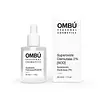What's inside
What's inside
 Key Ingredients
Key Ingredients

 Benefits
Benefits

 Concerns
Concerns

No concerns
 Ingredients Side-by-side
Ingredients Side-by-side

Water
Skin ConditioningJojoba Esters
EmollientCaprylic/Capric Triglyceride
MaskingGlycerin
HumectantMacadamia Integrifolia Seed Oil
Skin ConditioningHelianthus Annuus Seed Oil
EmollientEthyl Macadamiate
Skin ConditioningPropanediol
SolventPolyglyceryl-6 Distearate
EmulsifyingMoringa Oil/Hydrogenated Moringa Oil Esters
Skin ConditioningTricaprylin
MaskingLactococcus Ferment Lysate
Skin ConditioningHdi/Trimethylol Hexyllactone Crosspolymer
Dimethicone
EmollientSh-Oligopeptide-1
Skin ConditioningSh-Oligopeptide-2
Skin ConditioningSh-Polypeptide-1
Skin ConditioningSh-Polypeptide-9
Skin ConditioningSh-Polypeptide-11
Palmitoyl Tripeptide-1
Skin ConditioningPalmitoyl Tetrapeptide-7
Skin ConditioningPalmitoyl Tripeptide-38
Skin ConditioningN-Prolyl Palmitoyl Tripeptide-56 Acetate
Skin ConditioningAcetyl Hexapeptide-1
Skin ConditioningCeramide Ng
Skin ConditioningSodium Hyaluronate
HumectantBacillus/Folic Acid Ferment Filtrate Extract
AntioxidantTocopherol
AntioxidantMalic Acid
BufferingEthylhexylglycerin
Skin ConditioningLecithin
EmollientAcetyl Glutamine
Skin ConditioningXanthan Gum
EmulsifyingCarbomer
Emulsion StabilisingCetyl Alcohol
EmollientCetearyl Alcohol
EmollientPotassium Cetyl Phosphate
EmulsifyingHydroxypropyl Cyclodextrin
MaskingCaprylyl Glycol
Emollient1,2-Hexanediol
Skin ConditioningPentylene Glycol
Skin ConditioningSilica
AbrasiveSodium Lactate
BufferingDimethicone/Vinyl Dimethicone Crosspolymer
Skin ConditioningPhosphoric Acid
BufferingButylene Glycol
HumectantLactic Acid
BufferingSodium Chloride
MaskingPolysorbate 20
EmulsifyingCitric Acid
BufferingPhenoxyethanol
PreservativeSodium Benzoate
MaskingWater, Jojoba Esters, Caprylic/Capric Triglyceride, Glycerin, Macadamia Integrifolia Seed Oil, Helianthus Annuus Seed Oil, Ethyl Macadamiate, Propanediol, Polyglyceryl-6 Distearate, Moringa Oil/Hydrogenated Moringa Oil Esters, Tricaprylin, Lactococcus Ferment Lysate, Hdi/Trimethylol Hexyllactone Crosspolymer, Dimethicone, Sh-Oligopeptide-1, Sh-Oligopeptide-2, Sh-Polypeptide-1, Sh-Polypeptide-9, Sh-Polypeptide-11, Palmitoyl Tripeptide-1, Palmitoyl Tetrapeptide-7, Palmitoyl Tripeptide-38, N-Prolyl Palmitoyl Tripeptide-56 Acetate, Acetyl Hexapeptide-1, Ceramide Ng, Sodium Hyaluronate, Bacillus/Folic Acid Ferment Filtrate Extract, Tocopherol, Malic Acid, Ethylhexylglycerin, Lecithin, Acetyl Glutamine, Xanthan Gum, Carbomer, Cetyl Alcohol, Cetearyl Alcohol, Potassium Cetyl Phosphate, Hydroxypropyl Cyclodextrin, Caprylyl Glycol, 1,2-Hexanediol, Pentylene Glycol, Silica, Sodium Lactate, Dimethicone/Vinyl Dimethicone Crosspolymer, Phosphoric Acid, Butylene Glycol, Lactic Acid, Sodium Chloride, Polysorbate 20, Citric Acid, Phenoxyethanol, Sodium Benzoate
Ingredients Explained
These ingredients are found in both products.
Ingredients higher up in an ingredient list are typically present in a larger amount.
Citric Acid is an alpha hydroxy acid (AHA) naturally found in citrus fruits like oranges, lemons, and limes.
Like other AHAs, citric acid can exfoliate skin by breaking down the bonds that hold dead skin cells together. This helps reveal smoother and brighter skin underneath.
However, this exfoliating effect only happens at high concentrations (20%) which can be hard to find in cosmetic products.
Due to this, citric acid is usually included in small amounts as a pH adjuster. This helps keep products slightly more acidic and compatible with skin's natural pH.
In skincare formulas, citric acid can:
While it can provide some skin benefits, research shows lactic acid and glycolic acid are generally more effective and less irritating exfoliants.
Most citric acid used in skincare today is made by fermenting sugars (usually from molasses). This synthetic version is identical to the natural citrus form but easier to stabilize and use in formulations.
Read more about some other popular AHA's here:
Learn more about Citric AcidEthylhexylglycerin (we can't pronounce this either) is commonly used as a preservative and skin softener. It is derived from glyceryl.
You might see Ethylhexylglycerin often paired with other preservatives such as phenoxyethanol. Ethylhexylglycerin has been found to increase the effectiveness of these other preservatives.
Glycerin is already naturally found in your skin. It helps moisturize and protect your skin.
A study from 2016 found glycerin to be more effective as a humectant than AHAs and hyaluronic acid.
As a humectant, it helps the skin stay hydrated by pulling moisture to your skin. The low molecular weight of glycerin allows it to pull moisture into the deeper layers of your skin.
Hydrated skin improves your skin barrier; Your skin barrier helps protect against irritants and bacteria.
Glycerin has also been found to have antimicrobial and antiviral properties. Due to these properties, glycerin is often used in wound and burn treatments.
In cosmetics, glycerin is usually derived from plants such as soybean or palm. However, it can also be sourced from animals, such as tallow or animal fat.
This ingredient is organic, colorless, odorless, and non-toxic.
Glycerin is the name for this ingredient in American English. British English uses Glycerol/Glycerine.
Learn more about GlycerinPhenoxyethanol is a preservative that has germicide, antimicrobial, and aromatic properties. Studies show that phenoxyethanol can prevent microbial growth. By itself, it has a scent that is similar to that of a rose.
It's often used in formulations along with Caprylyl Glycol to preserve the shelf life of products.
Propanediol is an all-star ingredient. It softens, hydrates, and smooths the skin.
It’s often used to:
Propanediol is not likely to cause sensitivity and considered safe to use. It is derived from corn or petroleum with a clear color and no scent.
Learn more about PropanediolWater. It's the most common cosmetic ingredient of all. You'll usually see it at the top of ingredient lists, meaning that it makes up the largest part of the product.
So why is it so popular? Water most often acts as a solvent - this means that it helps dissolve other ingredients into the formulation.
You'll also recognize water as that liquid we all need to stay alive. If you see this, drink a glass of water. Stay hydrated!
Learn more about Water